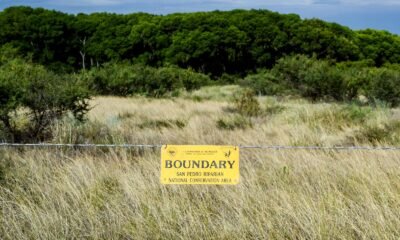Politics
Industrial Agriculture Capitalizes on Flaws in Groundwater Regulation

ELFRIDA — Concerns over groundwater depletion in southeastern Arizona have escalated as local residents grapple with the impacts of extensive agricultural development. Elaine Bailey, a community member, recently shared her distress regarding the drying up of her well at the Sunsites Community Center, citing the environmental degradation caused by neighboring farms’ water consumption.
Bailey expressed frustration, stating, “If the water goes, our homes aren’t worth anything. That’s the reality.” Her sentiments echoed the worries of others in the Sulphur Springs Valley as they sought answers from Arizona Attorney General Kris Mayes during her visit to the area. Mayes acknowledged the troubling situation and the breadth of the community’s plight.
Despite previous regulations aimed at curtailing groundwater usage, the Douglas basin has witnessed an explosion of agricultural projects in recent years. Initially designated as an Irrigation Non-expansion Area in 1980 and later transformed into an Active Management Area in 2022, these zones are supposed to limit additional irrigated land. Yet, an analysis by AZCIR indicates that thousands of previously dormant acres have recently been converted for cropping, largely led by large industrial farming operations.
The data reveals a staggering 600% increase in double cropping practices since 2008, with many large-scale operations draining water at unprecedented rates. Residents contend that these industrial farms exploit regulatory loopholes, leading to significant declines in nearby well water levels. Reports show some wells in the vicinity dropping over four feet annually.
With ongoing groundwater depletion, local lawmakers and residents question the effectiveness of existing regulations and the Arizona Department of Water Resources. Anastasia Rabin, a Bailey neighbor actively tracking agricultural expansions, noted the state agency’s failure to enforce relevant laws effectively.
As calls for action intensify, Mayes assigned blame to the Legislature for not passing adequate groundwater regulations for decades. This discontent was met with applause from local residents, who see Mayes’ potential as a catalyst for change.
The long-standing regulations allow property owners to use grandfathered watering rights, enabling new owners of older farmland to exploit these privileges, often with larger, more resource-intensive farming techniques. Despite intended restrictions, industrial-scale operations have emerged strong, especially in regions where water levels are critically low.
New evidence reveals that these farms have been consolidating land and leveraging their advantages to outpace smaller farmers. As the state grapples with these challenges, there are growing concerns about the sustainability of local water supplies amidst a wave of agricultural push and political maneuvering.
Contradicting the local community’s unease, recent assessments suggest ongoing litigation efforts from large farming enterprises, including those in Mohave County, aiming to contest the effectiveness of an Irrigation Non-expansion Area designation. Meanwhile, local groups, particularly in the Willcox basin, are contemplating designating their region as an INA to mitigate similar water crises, though skepticism about the effectiveness prevails.
As communities seek resolutions to these pressing issues, the larger question remains: will state regulations evolve to genuinely protect Arizona’s precious groundwater resources? The stakes are high, affecting both agricultural sustainability and community livelihoods throughout the region.


















